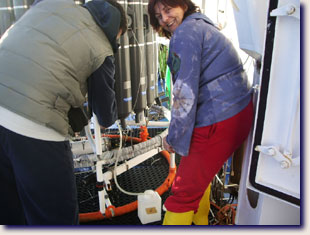We finally reached our first sampling point E5 this morning, which is near
Sardinia. We were fortunate that the big storm which was predicted to hit us
around midnight last night went another direction so we had relatively calm
seas. As I mentioned before the transit time from Messina is 28 hours to E5.
Around 8:00 AM we were able to begin our sampling, the rosette and CTD were cast, and also the box corer to a depth of around 200 meters. The sediment that the box corer brought up was quite coarse packed with shells, decapods, brachiopods and something looking like hard corals. Unfortunately we did not have much luck with the box corer the first couple of times, either because the corer landed on a slope or was pushed around by the strong underwater currents. Next the gravity corer was launched and that was quite an astonishing sight. It has a large cylinder that contains the weights then a tube which stretches for about 5 meters. Inside the metal pipe there is a PVC tube which collects the samples. It is armed and it takes several men just to put it into position. The CTD had to be moved to the stern, as the gravity corer could only be put over board on the side of the boat. |
 Francesco Soraci, Giovanna Maimone with CTD
Francesco Soraci, Giovanna Maimone with CTD
|
It was quite a scene when it slipped off its support and dropped onto the deck with a thud. Helmets and metal toe shoes are the order of the day. A research vessel can be a dangerous place in high waves or bad weather conditions, with all kinds of winches, hooks, and metal devices flying around. I had never worn a hard hat helmet before, they will never make it at Ascot! But it is safety first. The results of the gravity corer were promising as the scientists got a good two and a half meters of sediment. It was a pale yellow and contained shell like material.
Giovanna (Maimone) was once again happily at work filtering water samples, retrieved with the rosette, looking for bacteria and bio mass of phytoplankton and prokaryotic assemblages in her lab. We are all glad that the weather has calmed down, because all the scientists and crew are ready to work. Alessandra (Savini) and her colleagues have been busy with the CHIRP mapping and the Multi-beam mapping system. In fact the CHIRP has helped us locate areas where we will have the best luck in sending down the corers. Its sound probes deep into the sea bottom and sends back an echo which is plotted on a computer giving us an idea of the typography of the seafloor.
We will have finished with stations E4, E5 and E6 by this evening and will move into Area 3 and start with E7. Most of the day will be taken up with Multi-beam, CHIRP, and the corer activity.
That is all for now I am Siri Campbell reporting from the R/V Urania |
 Giovanna Maimone back to filtering
Giovanna Maimone back to filtering |



